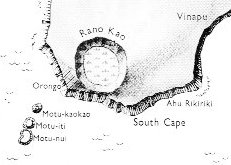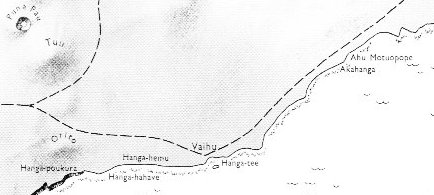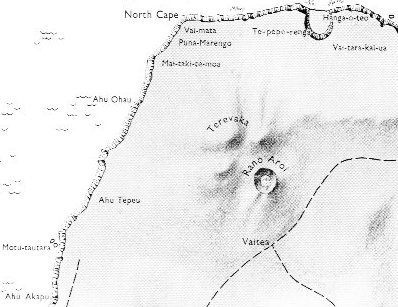3. Here it would have been easy to end the story of Kuukuu and the turtle, but there is more to tell. For instance should we remember how later on, when Hotu Matua had produced more offspring, he would reach the same position as Kuukuu, i.e. he must be buried: ... The king arose from his sleeping mat and said to all the people: 'Let us go to Orongo so that I can announce my death!' The king climbed on the rock and gazed in the direction of Hiva, the direction in which he had travelled (across the ocean). The king said: 'Here I am and I am speaking for the last time.'
The people (mahingo) listened as he spoke. The king called out to his guardian spirits (akuaku), Kuihi and Kuaha, in a loud voice: 'Let the voice of the rooster of Ariana crow softly. The stem with many roots (i.e., the king) is entering!' The king fell down, and Hotu A Matua died. Then all the people began to lament with loud voices. The royal child, Tuu Maheke, picked up the litter and lifted (the dead) unto it. Tuu Maheke put his hand to the right side of the litter, and together the four children of Matua picked up the litter and carried it. He and his people formed a line and went to Akahanga to bury (the dead) in Hare O Ava. For when he was still in full possession of his vital forces, A Matua had instructed Tuu Maheke, the royal child, that he wished to be buried in Hare O Ava. They picked him up, went on their way, and came to Akahanga.
They buried him in Hare O Ava. They dug a grave, dug it very deep, and lined it with stones (he paenga). When that was done, they lowered the dead into the grave. Tuu Maheke took it upon himself to cover the area where the head lay. Tuu Maheke said, 'Don't cover the head with coarse soil (oone hiohio)'. They finished the burial and sat down. Night came, midnight came, and Tuu Maheke said to his brother, the last-born: 'You go and sleep. It is up to me to watch over the father.' (He said) the same to the second, the third, and the last. When all had left, when all the brothers were asleep, Tuu Maheke came and cut off the head of Hotu A Matua. Then he covered everything with soil. He hid (the head), took it, and went up. When he was inland, he put (the head) down at Te Avaava Maea. Another day dawned, and the men saw a dense swarm of flies pour forth and spread out like a whirlwind (ure tiatia moana) until it disappeared into the sky. Tuu Maheke understood. He went up and took the head, which was already stinking in the hole in which it had been hidden. He took it and washed it with fresh water. When it was clean, he took it and hid it anew. Another day came, and again Tuu Maheke came and saw that it was completely dried out (pakapaka). He took it, went away, and washed it with fresh water until (the head) was completely clean. Then he took it and painted it yellow (he pua hai pua renga) and wound a strip of barkcloth (nua) around it. He took it and hid it in the hole of a stone that was exactly the size of the head. He put it there, closed up the stone (from the outside), and left it there. There it stayed ... The head stayed there until the rat (the kuhane of Hotu Matua) helped Ure Honu to find it, etc. There were 4 sons who carried the litter with the dead Hotu Matua, not 6 as those explorers who carried the wounded Kuukuu. The temporal pattern is 6 followed later on by 4. In between 6 and 4 the Sun King himself (5) must be located. He ought to be living from Anakena and onwards to the west, and the last of the kuhane stations, Ahu Akapu, lies at bottom left on the map below:
It is possible to order the kuhane stations in a table where each station covers 15 days:
I have used information in The Eighth Island about Papa O Pea and Ahu Akapu as residences for the future respectively for the abdicated king. The word ahu does not only refer to a funerary stone monument (similar to the pipi horeko heaps) but also means swollen:
Possibly the swollen foot of tagata in Ga5-12 is meant to signify an ahu, and the unusual haga rave at left could refer to the 'cave' into which Kuukuu was taken to be 'recovered' (hakaora):
An alternative reading (to Hanga Te Pau) could be Ahu Akahanga, and possibly the creators of Manuscript E played with the name and glyph for the Sun King final (Ahu Akahanga) in order to indicate a parallel station for the Moon Queen (Hanga Te Pau). By arranging the stations as in the table above, in groups with 8 stations in each, the method is similar to how the Babylonians once used to count the days of the week - for each new group (day) the 'leader' would be the next in line. ... the Chaldean astrologers introduced the 7-day week which has come down into the present. The number was convenient because the seers recognized seven planets: Saturn, Jupiter, Mars, Sun, Venus, Mercury and the Moon, each of which governed one hour of the day. If, for illustration, Saturn ruled the first hour of a certain day followed by each of the 'planets' in turn, he also ruled the eighth, fifteenth, and twenty-second hours. Jupiter was lord of the second, ninth, sixteenth, and twenty-third hours; Mars presided over the third, tenth, seventeenth, and twenty-fourth hours, and the Sun took charge of the first hour of the succeeding day. Since the planet which ruled the first hour gave his name to the entire day, Sunday thus followed Saturn-day, and this was the way the names of the days of the week came into existence out of ancient Chaldean astrology ... 24 hours in a day is equal to 3 * 7 + 3, which can be transformed into 3 times 7 + 1. The distribution of the kuhane stations could for instance be:
Although it is pleasing to find Moon and the 20th station (Hanga Hoonu) at the end of this table it would be very difficult to follow the path on the map of Easter Island, because each step would necessitate a jump. It would be as to follow the movements of a shuttle in a loom: ... the king moved about - as Professor Frankfort states in his account - 'like the shuttle in a great loom' to re-create the fabric of his domain, into which the cosmic powers represented by the gods, no less than the people of the land, were to be woven ... When the creators of Manuscript E wrote that the explorers stayed outside the cave of Kuukuu for 27 days this number was probably not an objective measure of how long they really were there, instead we should interpret 27 as a reference to the 27th kuhane station, Ahu Akapu, the 'hole' (pu) wherein Kuukuu had to 'drop anchor'. Tuu Maheke buried the head of Hotu Matua at Te Avaava Maea, and in this name we can first identify ava = entrance to a harbour. Maea means stone, and we should once again think of those 6 pipi horeko heaps which probably represent Tauono (the six stones) at the beginning of the new year:
|
|||||||||||||||||||||||||||||||||||||||||||||||||||||||||||||||||||||||||||||||||||||||||||||||||||||||||||||||||



